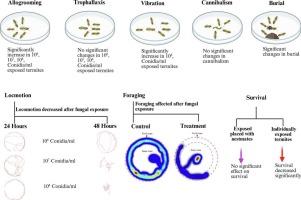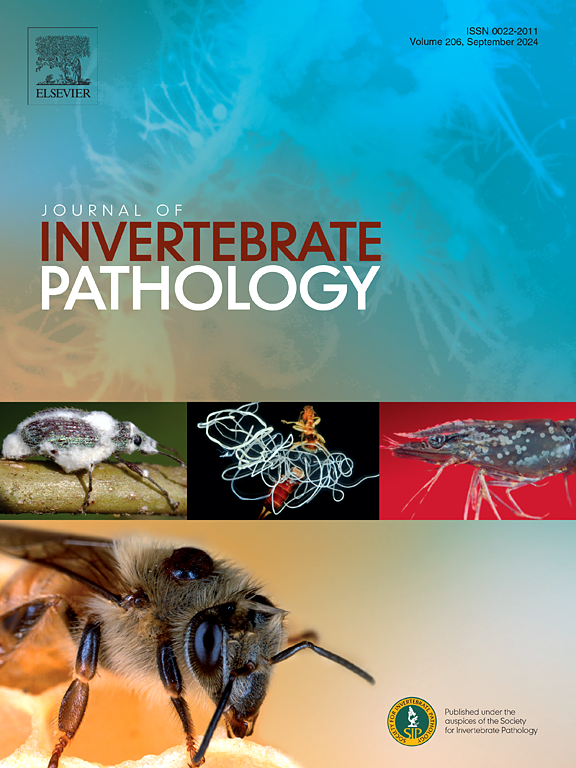球孢白僵菌对中国白蚁行为的影响。
IF 2.4
3区 生物学
Q1 ZOOLOGY
引用次数: 0
摘要
白蚁扮演着双重生态角色,既是重要的分解者,又是造成全球经济损失的重要害虫。在中国,中国白蚁(Reticulitermes chinensis)是一种普遍存在的地下白蚁,主要通过化学杀白剂进行管理,对环境和健康构成威胁。昆虫病原真菌(EPF),特别是球孢白僵菌(Beauveria bassiana),由于其生态友好的目标防治方法,提供了一个有希望的替代方案。本研究探讨了球孢白僵菌对中华白僵菌不同行为(异源梳洗、养养、振动、同类相食、埋藏、移动和觅食)及存活率的影响。暴露于较高真菌浓度(108分生孢子/ml)的白蚁表现出显著增加的异源修饰和振动行为,而滋养性未受影响。埋葬行为对真菌杀死的白蚁的反应明显比对照组(通过冷冻杀死的尸体)更明显,尽管同类相食在两种尸体类型之间没有显着差异。运动分析表明,暴露后24和48 h,球孢白僵菌降低了运动距离和速度,增加了转弯角度和角速度。感染后的觅食活动明显中断,花费的时间减少,访问食物区次数减少。单独关在笼子里的白蚁死亡率是剂量依赖性的,但当白蚁与同伴关在笼子里时,没有观察到显著的生存差异,表明潜在的社会缓冲效应。这些发现表明球孢白僵菌不仅影响白蚁的生存,而且改变白蚁的行为,突出了其作为生物防治剂的潜力。然而,白蚁的行为防御可能会减轻真菌的传播,因此有必要进一步研究优化真菌在群居昆虫群体中的致病性。本文章由计算机程序翻译,如有差异,请以英文原文为准。

Effect of entomopathogenic fungus Beauveria bassiana on behavior of termite Reticulitermes chinensis
Termites play a dual ecological role as vital decomposers and significant pests that cause economic damage globally. In China, Reticulitermes chinensis is a prevalent subterranean termite species managed primarily through chemical termiticides, which pose environmental and health risks. Entomopathogenic fungi (EPF), particularly Beauveria bassiana, offer a promising alternative due to their eco-friendly targeted approach to pest control. This study investigated the effects of B. bassiana on various behaviors (allogrooming, trophallaxis, vibration, cannibalism, burial, locomotion, and foraging) and the survival of R. chinensis. Termites exposed to higher fungal concentrations (108 conidia/ml) showed significantly increased allogrooming and vibration behaviors, while trophallaxis remained unaffected. Burial behavior was significantly more pronounced in response to fungus-killed termites compared to controls (cadavers killed by freezing), though cannibalism showed no significant difference between the two dead cadaver types. Locomotion analysis revealed that exposure to B. bassiana reduced distance moved and velocity, while increasing turn angle and angular velocity, as measured at 24 and 48 h after fungal exposure. Foraging activity after infection was notably disrupted, with reduced time spent and fewer visits to food zones. Mortality was dose-dependent in individually caged termites, but no significant survival differences were observed when termites were caged with nestmates, suggesting potential social buffering effects. These findings demonstrate that B. bassiana not only impacts termite survival but also alters behaviors, highlighting its potential as a biological control agent. However, termite behavioral defenses may mitigate fungal spread, necessitating further investigation into optimizing fungal pathogenicity within social insect colonies.
求助全文
通过发布文献求助,成功后即可免费获取论文全文。
去求助
来源期刊
CiteScore
6.10
自引率
5.90%
发文量
94
审稿时长
1 months
期刊介绍:
The Journal of Invertebrate Pathology presents original research articles and notes on the induction and pathogenesis of diseases of invertebrates, including the suppression of diseases in beneficial species, and the use of diseases in controlling undesirable species. In addition, the journal publishes the results of physiological, morphological, genetic, immunological and ecological studies as related to the etiologic agents of diseases of invertebrates.
The Journal of Invertebrate Pathology is the adopted journal of the Society for Invertebrate Pathology, and is available to SIP members at a special reduced price.

 求助内容:
求助内容: 应助结果提醒方式:
应助结果提醒方式:


